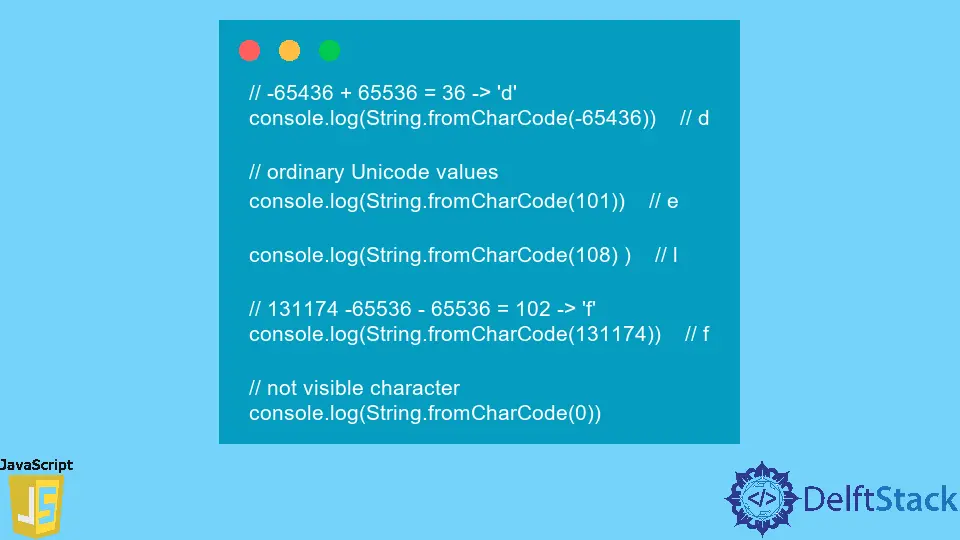JavaScript String.fromChar() Method
-
Syntax of JavaScript
String.fromCharCode(): -
Example Codes: Convert the UTF-16 Unicode Value to a Character Using JavaScript
String.fromCharCode() -
Example Codes: Convert Multiple UTF-16 Code Units Into a Single String Using JavaScript
String.fromCharCode() -
Example Codes: Behavior of the JavaScript
String.fromCharCode()

The JavaScript String.fromCharCode() converts the UTF-16 Unicode values into characters and combines them in a string in the order they were provided in parameters. The String.fromCharCode() method is a static method of the String.
Therefore, this method does not need a calling object. Instead, the method gets invoked through the string constructor object String.
Syntax of JavaScript String.fromCharCode():
String.fromCharCode(code_1);
String.fromCharCode(code1, code2, ... , codeN)
Parameters
code_1 |
A numerical value representing the UTF-16 Unicode value in the range of 0 to 65535. This is the Code unit that is converted into character. |
code1,code2,...,codeN |
A series of UTF-16 Unicode values to convert into characters combined in a string. N is the number of parameters. |
Return
The JavaScript String.fromCharCode() method returns a string rather than a string object.
Example Codes: Convert the UTF-16 Unicode Value to a Character Using JavaScript String.fromCharCode()
The code_1 parameter can be provided in decimal, hexadecimal, or any other number system as long as it represents the UTF-16 Unicode value.
const code_1= 68 //decimal value
const code_2 = '0x44' //hexadecimal value
console.log(`Converted ${code_1} to `,String.fromCharCode(code_1));
console.log(`Converted ${code_2} to `,String.fromCharCode(code_2));
No calling object was created here to call the static function but only used it as String.fromCharCode().
Output:
Converted 68 to D
Converted 0x44 to D
Above, the String.fromCharCode() took the UTF-16 code as parameter and converted into character. The returned string is printed on the screen.
Example Codes: Convert Multiple UTF-16 Code Units Into a Single String Using JavaScript String.fromCharCode()
In this example, a series of Unicode values are converted into characters and combined in a single string.
console.log(String.fromCharCode(68,101,108,102,116,83,116,97,99,107))
Unicode values are passed into the function through the code1, code2,..., codeN parameters. N is the number of parameters, and its value is 10 in this example.
This example also demonstrates that String.fromCharCode() is case-sensitive while converting the Unicode values into characters.
Output:
DelftStack
The console displays the returned string DelftStack. The method converted and combined the Unicode values in the returned string in the order they were given in the parameters.
Example Codes: Behavior of the JavaScript String.fromCharCode()
This example shows the behavior of the JavaScript String.fromCharCode() method when the numerical value given in the code_1 parameter is:
- Less than the valid range (
code_1< 0). Then the method keeps adding 65536 until the value is within the valid range of 0 to 65536. - Greater than the valid range (
code_1> 65536). Then the method keeps subtracting the number 65536 until the value is within the valid range(0 to 65536).
// -65436 + 65536 = 36 -> 'd'
console.log(String.fromCharCode(-65436)) // d
// ordinary Unicode values
console.log(String.fromCharCode(101)) // e
console.log(String.fromCharCode(108) ) // l
// 131174 -65536 - 65536 = 102 -> 'f'
console.log(String.fromCharCode(131174)) // f
// not visible character
console.log(String.fromCharCode(0))
Output:
d
e
l
f
�
The JavaScript String.fromCharCode() prints a null character or a character that is not visible when it fails to convert the code_1 parameter into a character.